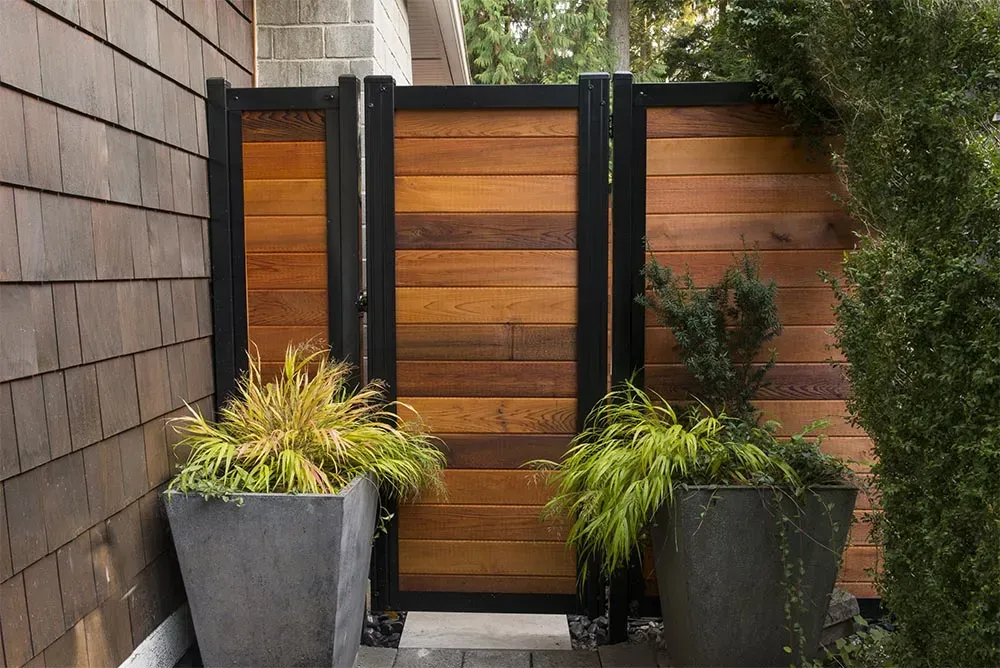
How to Build a Fence Gate: A Simple Step-by-Step Guide for Beginners

Is your beautiful fence missing its finishing touch? A well-built gate can make all the difference! It's the part of your fence that gets used the most, yet many people feel nervous about building one themselves.
Don't worry - learning how to build a fence gate isn't as hard as you might think. With the right tools and a little guidance, you'll have a sturdy, functional gate that perfectly matches your fence.
We've broken down the process into simple steps that anyone can follow. Whether you're completing a fence project or replacing an old, sagging gate, this guide will help you create a gate you can be proud of!
What You'll Need
Before you start, gather these materials and tools:
Materials:
Pressure-treated lumber (same type as your fence)
Galvanized deck screws (2½ or 3 inches)
Gate hinges (2-3 depending on gate size)
Gate latch
Post caps (optional)
Wood sealer or paint
Tools:
Tape measure
Pencil
Level
Power drill
Saw (circular saw or miter saw)
Clamps
Square
Post hole digger (if installing new posts)
According to Home Depot, choosing the right hardware is crucial for a long-lasting gate. Always use exterior-grade screws and galvanized or stainless steel hinges to prevent rust.
How To Build A Fence Gate: Step-by-Step Instructions
Step 1: Measure and Plan Your Gate
First, decide exactly where your gate will go and how wide it should be.
Measure the opening between your fence posts.
Subtract 1-1.5 inches from this measurement to allow space for the gate to swing.
Standard width for a walking gate is 3-4 feet, while a driveway gate might be 10-12 feet.
Draw a simple plan with measurements.
Family Handyman recommends making your gate slightly narrower than the opening to prevent binding when wood expands in humid weather.
Step 2: Prepare the Posts
Make sure your gate posts are strong enough to support your gate.
Check that existing posts are firmly set in concrete.
If installing new posts, dig holes 1/3 the height of your post.
Place posts in holes and check they're plumb (perfectly vertical) using a level.
Fill holes with concrete and let cure completely (24-48 hours).
The American Wood Council notes that posts should be set at least 24 inches deep for gates under 4 feet wide, and deeper for larger gates.
Step 3: Build the Gate Frame
Next, create a sturdy frame that won't sag over time.
Cut two vertical pieces (stiles) to the height of your fence.
Cut two horizontal pieces (rails) to the width you calculated in Step 1.
Lay the pieces on a flat surface in a rectangle.
Apply wood glue to the joints.
Attach the pieces using 3-inch deck screws (2 screws per corner).
Add a diagonal brace from top hinge side to bottom latch side.
According to This Old House, the diagonal brace is crucial - it prevents sagging by transferring weight to the hinge side of the gate.
Step 4: Add the Pickets or Boards
Now it's time to make your gate match your fence.
Measure and cut your pickets or boards to the right height.
Starting at one end, attach boards to the frame.
Use a small board as a spacer to keep gaps even (if your fence has gaps).
Check that boards are level at the top.
Secure each board with at least two screws per rail.
Better Homes & Gardens suggests pre-drilling holes to prevent the wood from splitting when you add screws.
Step 5: Attach the Hinges
Proper hinge placement is key to a gate that swings smoothly.
Position the gate in the opening, using shims to keep it 1/2 inch off the ground.
Place hinges about 8 inches from the top and bottom of the gate.
Mark screw holes on both the gate and post.
Pre-drill holes for the screws.
Attach hinges to the gate first, then to the post.
How do I build a fence gate that doesn't drag? Popular Mechanics recommends installing a third hinge in the middle for gates wider than 4 feet to prevent sagging.
Step 6: Install the Latch
Choose a latch that's easy for you to use but secure enough for your needs.
Hold the gate closed in its final position.
Mark where the latch will go on both the gate and the adjoining post or fence.
Pre-drill holes for screws.
Attach the latch according to the manufacturer's instructions.
Test the latch to make sure it closes and opens easily.
Step 7: Finish and Weatherproof Your Gate
Protect your work from the elements so it lasts for years.
Sand any rough edges.
Apply wood sealer, stain, or paint to match your fence.
Add post caps if desired to prevent water damage.
Apply a second coat of finish after the first has dried.
Consumer Reports tests show that a quality exterior finish can extend the life of outdoor wood by many years.
Common Problems and How to Fix Them
If Your Gate Sags:
Add a diagonal brace running from the top hinge side to the bottom latch side.
Install a tension cable with a turnbuckle that you can tighten as needed.
Replace hinges with stronger ones.
If Your Gate Won't Close Properly:
Check that posts are truly vertical using a level.
Adjust hinges slightly.
Sand or plane the edge of the gate if it's rubbing.
If Your Gate Is Hard to Open:
Make sure hinges are well-oiled.
Check for ground obstructions.
Raise the gate slightly on the hinges.
Conclusion
Building your own fence gate might seem challenging at first, but by following these simple steps, you'll create a sturdy, functional entrance that completes your fence beautifully. The satisfaction of using a gate you built yourself makes every effort worthwhile!
Remember that practice makes perfect, so don't be too hard on yourself if your first attempt isn't flawless. Focus on building a strong structure first, and you can always adjust the details later.
Now that you know how to build a fence gate, you can confidently tackle this project and enjoy the results for years to come!
4. Maintenance Free Fencing

© 2025 | All Rights Reserved | Privacy Policy